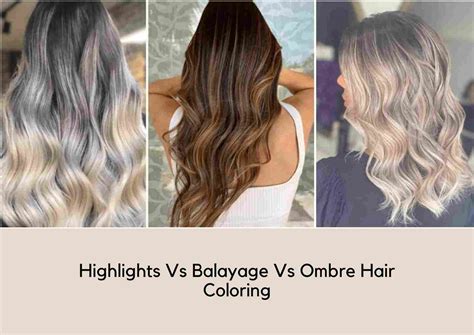In the world of hair coloring, ombre and balayage reign supreme as two of the most sought-after techniques. While both methods involve creating a gradual transition of color from one shade to another, their distinct approaches yield unique results. Understanding the nuances between ombre and balayage can empower you to make an informed decision about which technique is right for you.

**Ombre: Gradual Transition from Dark to Light**
Ombre, derived from the French word for “shadow,” entails bleaching the lower half of the hair while leaving the roots untouched or darkening them slightly. This creates a dramatic two-tone effect, often with a distinct line of demarcation between the lighter and darker sections. Ombre is particularly flattering on long hair, as it allows for a seamless transition from dark roots to lighter tips.
**Balayage: A More Natural Gradient**
Balayage, on the other hand, is a freehand painting technique that involves strategically placing highlights throughout the hair to create a sun-kissed, blended look. Unlike ombre, balayage does not involve bleaching the entire lower half of the hair, resulting in a more gradual and natural gradient. Balayage is versatile and can be customized to suit various hair types and lengths, making it a popular choice for those seeking a subtle yet impactful transformation.
Motivations for Choosing Ombre vs. Balayage
Ombre:
- Creates a bold and contrasting effect
- Low maintenance, requiring fewer touch-ups
- Suitable for long hair, especially straight or wavy
Balayage:
- Provides a more natural and blended look
- Customizable to different hair types and lengths
- Ideal for those seeking a subtle but noticeable change
**Pain Points to Consider**
Ombre:
- Can appear too harsh or unnatural if not done correctly
- Requires regular touch-ups to maintain the contrast
- May damage hair if bleaching is not done with care
Balayage:
- Can be more expensive than ombre due to its labor-intensive process
- May require more frequent appointments for maintenance
- May not be suitable for very short hair
**Common Mistakes to Avoid**
Ombre:
- Using too harsh of a bleach, resulting in brassy or damaged hair
- Not blending the colors properly, leading to a noticeable line of demarcation
- Applying bleach too close to the roots, causing scalp irritation
Balayage:
- Over-highlighting, resulting in an unnatural or “blocky” look
- Using the wrong color of highlights, which can clash with the base color
- Not sectioning the hair properly, leading to uneven distribution of highlights
FAQs
1. Which technique is more damaging to hair?
While both ombre and balayage involve some level of bleaching, balayage is generally less damaging as it does not involve bleaching the entire lower half of the hair.
2. How often should I touch up my hair?
Touch-up frequency depends on the desired color contrast and your hair growth rate. Ombre typically requires touch-ups every 2-4 months, while balayage can last longer, up to 6-8 months.
3. Can I do ombre or balayage at home?
It is highly recommended to have ombre or balayage done by a professional hairstylist to ensure proper application and blending. Attempting these techniques at home can lead to uneven results and potential hair damage.
4. Which technique is better for my hair type?
Ombre is ideal for long, straight, or wavy hair, while balayage is more versatile and suitable for various hair types and lengths. Consult with your hairstylist for personalized recommendations.
5. How much does ombre or balayage cost?
The cost of ombre or balayage can vary depending on the length of your hair, the complexity of the desired color, and the expertise of the hairstylist. On average, expect to pay between $100 to $400 per session.
6. How can I prevent damage to my hair from ombre or balayage?
- Use color-safe shampoos and conditioners
- Limit heat styling and use heat protectants
- Get regular trims to remove split ends
- Deep condition your hair regularly
Conclusion
Whether you desire a bold statement or a subtle transformation, ombre and balayage offer distinct hair coloring solutions. Understanding the differences between these techniques empowers you to make an informed decision that aligns with your style, hair type, and lifestyle. Consult with a reputable hairstylist to ensure a flawless and impactful result.
